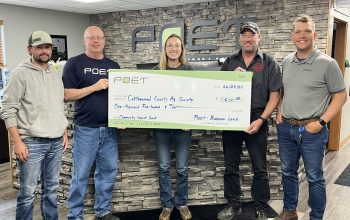Sept 7, 2023 –
“No Eminent Domain for Private Gain”
Wright County Land Owners' Fight Against Eminent Domain
What is a C02 Pipeline?
Carbon capture and storage is a process that involves capturing carbon dioxide emissions from industrial processes, power plants, and other sources before they are released into the atmosphere. The captured carbon dioxide is then stored underground. The aim is to prevent CO2 from entering the atmosphere and contributing to climate change. Before the carbon dioxide is stored, it needs to be transported to the storage site. That is where a carbon dioxide pipeline comes into play.
Who Owns Carbon Solutions?
Summit Carbon Solutions, owned by Bruce Rastetter, is proposing a carbon pipeline to run through Wright County, along with 29 other counties in Iowa. The Wright County Monitor spoke in depth about the proposed pipeline with those affected. We were told to "follow the money," and that is what we did.
Following the Money
Iowa's prominent politicians are connected to wealthy individuals who support plans for carbon pipelines. Many of the top politicians in Iowa have received financial support from Bruce Rastetter, the owner of Summit Carbon Solutions, according to the Iowa Ethics & Campaign Disclosure Board. Governor Kim Reynolds has received a total of $188,902 in donations from Rastetter. Additionally, executives from Navigator, another carbon capture company, have made their own financial contributions to those in power. Politicians who have received donations prior to the 2022 session from the aforementioned companies are as follows: House Majority Leader Pat Grassley, Senate Majority Leader Jack Whitver, and Governor Reynolds.
Given these financial connections, it's not shocking that these three politicians fought a proposed law last spring that would stop big businesses from taking land for purposes such as carbon capture. It's also worth noting that the three-person board responsible for deciding whether the use of eminent domain is permissible is chosen by the Governor. Furthermore, the Bipartisan Infrastructure Law, introduced by President Biden and Presidential Envoy for Climate, John Kerry, has allotted $12 billion for carbon management projects. Some of these funds are going to three studies into how to transport carbon dioxide from ethanol facilities, power plants, and other industrial operations for permanent storage or reuse, according to a report from APNews. At the writing of this article, it is not known what areas or companies are involved in the government-funded studies.
Local Concerns of Saftey: Assume all of the Risks for a One-Time Payment
In the event of a problem with the pipeline, the initial concern for many would be the possibility of an explosion. After speaking with Betty Ellis, an affected landowner in Wright County, the biggest problem isn’t the explosion, but the CO2 that would be released into the air after an explosion. CO2 is an asphyxiant gas that diminishes the available oxygen in the atmosphere. CO2 has the ability to travel large distances at lethal concentrations from the pipeline after a rupture. That does not undermine the effect an explosion would have, such as throwing large sections of pipe, expelling pipe shrapnel, and creating craters. According to the proposed pipeline mapping, there would be numerous houses that are close to the pipeline. With limited government regulations, there is not a certain amount of distance required between a CO2 pipeline and an occupied structure. In Iowa, hog confinements are required to be at least 1,875 feet from homes and 2,500 feet from public use areas. One of the homes in Wright County will be less than 700 feet, or about one tenth of a mile, away from the proposed pipeline. There is not much known about the plume of a carbon pipeline leak or explosion since Summit Carbon Soulutions have not organized a plume study.
To use eminent domain, you have to prove it's for the benefit of the public. Those who want to take land for the carbon pipeline believe it's for the common good, as it helps reduce pollution and combat global warming by burying carbon in North Dakota. But Betty Ellis disagrees; she doesn't think carbon emissions cause global warming, so she's fighting against land seizures. She's not alone; about 70% of Iowans don't want land taken for private companies. Summit Carbon Solutions, while receiving federal funding, is privately owned.
She doesn't consider the short-term compensation to elevate the long-term hassle. Ellis also noted that CO2 is needed for photosynthesis, the driving force behind farming. Ellis noted that if CO2 is taken out of the atmosphere, farmers might need to supplement it for their crops to grow later on. Could farmers who have the pipeline on their land use it, as Ellis suggested to the Ames-based company? Unfortunately, the answer was no.
The Ellis family had various reasons for not signing the initial easement, and one significant factor was the reduced value of their farmland. She states that landowners would assume all the risk for a one-time payment. Betty Ellis highlighted during the second week of the evidentiary hearing for Summit Carbon Solutions' hazardous pipeline permit application with the Iowa Utilities Board that she chose not to sign the land easement initially. Her decision stemmed from the belief that there should have been a permit in place before requesting signatures.
First Generation Farmer Fighting to Keep Land Profitable
Ellis is not alone in the fight against Summit Carbon Solutions. 70% of Iowans are against the use of eminent domain for private businesses. Robert Ritter is a part of that 70%. "No eminent domain for private gain," stated Ritter when I spoke with him about his part in the hearing. Ritter shared under oath that the easement he was requested and refused to sign states that Summit can sell, abandon, or replace the pipeline. He worries about what that would mean in the future, as Summit has a history of different ownership. Who would his land, which he is now sharing with a young farmer, go to in the event that the private company sells?
Ritter shared with the Utility Board that he is a first-generation farmer. He bought his land in 1992; it required a lot of work to be made profitable. One of the updates Ritter had to fund was extensive tiling of his field. Drainage tiles are about 60 feet apart and go in every direction depending on the gentle slopes of the land. The Summit Carbon Pipeline would have to cut 26 of Ritter's tile lines. The company also requests digging under two county drainage tiles that are over 100 years old. These tiles are still functioning and serve more than just Ritter’s farm ground.
Farm Tiles, Safeguarding the Black Gold of Iowa
Courtney Morris, the Wright County Drainage Clerk, primarily focuses on drainage tiles and open drainage ditches. Historically, Wright County's soil was swampy, but the introduction of field tiles in 1880 made us a leader in crop production. Morris noted that some of these century-old tiles, including two on Ritter's property, still function effectively. However, not all tiles on Wright County farming properties, or town properties, have updated records. This poses potential county wide flooding issue if a break occurs.
To tackle these concerns, county supervisors and Morris collaborated on a 19-page resolution to shield property owners if the pipeline project is approved. They've shared this resolution and permits statewide, aiding other counties in adopting similar safeguards. The resolution is accessible online and at the Wright County courthouse. Morris is confident it offers unique protection.
The drainage clerk posed a significant question: "What if our contractors accidentally hit the pipeline while repairing a tile line?" The company asserts that multiple shut-off valves would be placed across the county. However, the experience of a rural town in Mississippi tells of a devastating outcome when safety is overlooked.
A Lethal Leak
In Satartia, Mississippi, heavy rainfall in 2020 caused the soil around the carbon pipeline to shift, leading to a break in the pipe weld. This incident resulted in a destructive explosion involving ice and carbon dioxide, as revealed by a federal investigation. Residents of Satartia were overcome minutes after the carbon pipeline, less than half a mile away from their town, leaked. According to a 19-month investigation from The Huffington Post, residents' breathing ability was affected almost immediately after the large boom.
The released CO2 hindered evacuation efforts by stalling cars, depriving them of the oxygen needed to operate. Inhaling CO2 leads to many problems, including headaches, dizziness, nausea, shortness of breath, memory issues, disorientation, convulsions, increased heart rate, unconsciousness, and even death. Most of which the residents experienced during the crisis.
Initial responders lacked training to handle the crisis in Satartia. Jarika Beecher, Wright County's Emergency Management official, noted that if the pipeline gains approval, Summit Carbon Solutions would provide annual training for emergency personnel. Beecher shared that a secondary hazmat team, located in Fort Dodge, would respond to emergencies as well. Residents of Satartia continue to suffer lasting issues. Unfortunately, we were unable to find information regarding compensation for the most affected citizens.
Permit Rejected in North Dakota
In the grander scheme, this disruption within Wright County is a component of a broader carbon pipeline project under consideration nationwide. The North Dakota Public Service Commission has declined Summit Carbon Solutions' permit application, asserting that the company did not sufficiently demonstrate that the project would result in minimal negative impacts on the environment and the well-being of North Dakota citizens. The review of the permit for Summit Carbon Solutions is projected to last about a month in Fort Dodge. Various resources were used in the writing of this article.


